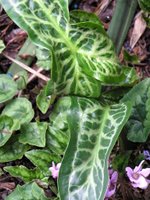
In my garden, the onset of Autumn with its cooler temperatures is a period of transition.
With exotics beginning to wind down ready for the Winter, Autumn bulbs and corms come into growth, bringing some cheer to the impending gloom.
Autumn Crocus, Colchicums ( Naked Ladies ) Sternbergia and of course Cyclamen sp. with their infinite leaf patterns all add interest and colour.
Amongst all this activity, there's also a member of the Aroid family ( two if you count Biarum sp. ) which comes into growth at this time of year, the Arums.
I tend to split Arums into two types, those grown for their leaf colour or pattern and those grown for the colour of their spathe.
Of the twenty five or so species the most well known is probably Arum Italicum "Marmoratum" syn "Pictum". ( Pictured with Cyclamen Hederifolium. )
Grown for the beauty of its leaves, this Arum is popular with gardeners and those who are interested in flower arranging, the leaves look good in Winter flower arrangements.
Two other Arums which are popular are A.Creticum and A.Dioscoridis, these two are grown for the colour of their spathe.
A.Italicum has one of the widest distributions of all the Arums, growing in Europe, the Mediterranean, East towards the Caucasus, North Africa and a few other places in between.
There are four subspecies, Albispathum, Canariense, Italicum and Neglectum.
There are also several named selections available here, "Bill Baker", "Chameleon", "Ghost" and "Tiny" being four of them.
There are more, but they only seem to be on sale in the U.S.A.
All the Italicums are worth growing, ( I'm biased ) but "Marmoratum" is probably the easiest to find, with the subspecies and named selections falling into the realm of the specialist grower/nursery.
A.i. "Marmoratum" is a plant best seen before you buy, as are the named selections.
This is because they can be very variable. The vein colour and leaf pattern on some samples I've seen, has been very insipid, while others have a good strong cream to almost white colour.
So, if its possible to get to a nursery or two, this gives you the opportunity to pick out a good form.
This is the first of the sunlovers, grown for the colour of their spathe.
From Crete, the Eastern Mediterranean and Turkey, comes everyones favourite Arum. A.Creticum.
This has been popular ever since it was first brought into cultivation, the Primrose Yellow spathe and sweet perfume making it an instant hit.
Easy to grow and an unashamed sunlover, it will bring a splash of colour to the Spring garden.
You may well come across a form of this with the grand title, A.Creticum (F.C.C.) clone. ( The F.C.C. stands for First Class Certificate. )
Allthough I've never had any frost problems with A.Creticum, if you live in a particularly cold area, this is the one to buy as it's reliably hardy.
This is the second one.
A.Dioscoridis, is another Arum that's popular with growers.
There are four variations, var.cyprium, var.dioscoridis, var.philistaeum and var.syriacum.
Of these, the plant formerly known as A.Diorscoridis v.spectabile is probably the most popular.
This plant is now called A.Dioscoridis v.dioscoridis.
Confusing innit!
These are all native to the Eastern Mediterannean, Cyprus and the Middle East including Lebanon, Palestine and Syria.
These plants are notable for the maroon, sometimes almost black spots and blotches on the spathe.
Of the Arums featured here, the "Italicums" are the most accomodating.
These will grow happily in sun to fairly dark shade, allthough hiding them away seems like a waste to me.
In front of hedges, beneath decidous trees and shrubs and shady rockeries, are all good places for planting out.
A.Creticum and A.Dioscoridis, I always plant these in full sun, allthough they will grow succesfully in light shade.
If you live in a very cold area, try to find a warm, sunny, sheltered spot for them.
Good places are in front of south or west facing walls and fences.
Like Ariseamas, I plant Arums deep, at least 6ins. minimum.
Drainage is very important and the bottom of the planting hole should be thoroughly loosened up.
I dig in plenty of well rotted manure and add a handfull of fish, blood and bone fertilizer.
I also use the baskets, which I mentioned in the Ariseama blog, this makes lifting the corms and collecting offsets easy.
Arums, are best grown in "Long Tom" pots.
I use a mixture of J.I.No2, well rotted manure and Perlite.
Err on the side of to much drainage, Arums will not tolerate waterlogging.
To this, I add some fish, blood and bone fertilizer and some long life fertilizer pellets.
Don't water the plants until you see signs of growth, then water modestly keeping them just damp.
Even when in full growth, don't go mad with the watering as any excess can lead to the corm rotting.
Arums are easily grown from seed or offsets, simply follow the instructions given in my Growing Ariseamas blog.
The only modifications I make, is to add a bit more drainage to the compost and give them a bit more light when in growth. Posted by Mike.
Note: Arums are generally trouble free plants, but watch out for slugs, as these seem to relish the leaves.
One good tip, is to mist the pots and young growth with Cheshunt Compound, this will help prevent any problems with "Damping Off".
Even better, is don't get the pots too wet in the first place.




